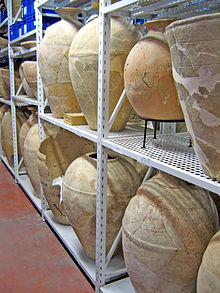Israel Antiquities Authority
Independent Israeli governmental authority From Wikipedia, the free encyclopedia
Independent Israeli governmental authority From Wikipedia, the free encyclopedia
The Israel Antiquities Authority (IAA, Hebrew: רשות העתיקות rashut ha-'atiqot; Arabic: داﺌرة الآثار, before 1990, the Israel Department of Antiquities) is an independent Israeli governmental authority responsible for enforcing the 1978 Law of Antiquities. The IAA regulates excavation and conservation, and promotes research. The Director-General is Eli Escusido and its offices are housed in the Rockefeller Museum.
 | |
 Israel Antiquities Authority storage room | |
| Formation | 1948 |
|---|---|
| Headquarters | Jerusalem |
| Website | www |


As of 2014 it planned to move into a new building for the National Campus for the Archaeology of Israel in Jerusalem, next to the Israel Museum.[1][needs update]
The Israel Department of Antiquities and Museums (IDAM) of the Ministry of Education was founded on July 26, 1948, after the establishment of the State of Israel. It took over the functions of the Department of Antiquities of the British Mandate in Israel and Palestine. Originally, its activities were based on the British Mandate Department of Antiquities ordinances.
IDAM was the statutory authority responsible for Israel's antiquities and for the administration of small museums. Its functions include curation of the state collection of antiquities, storing of the state collection, maintaining a list of registered antiquities sites, inspecting antiquities sites and registering newly discovered sites, conducting salvage and rescue operations of endangered antiquities sites, maintaining an archaeological library (the state library), maintaining an archive.
The Israel Antiquities Authority (IAA) was created from the IDAM by the Knesset (Israeli parliament) in a 1990 statute. Amir Drori became its first director. The IAA fulfilled the statutory obligations of the IDAM and in its early days was greatly expanded from the core number of workers in IDAM to a much larger complement, and to include the functions of the Archaeological Survey of Israel project, ending the activity of the Association for the Archaeological Survey of Israel (1964-1988). The period of expansion lasted for a number of years, but was followed by a period in which diminished fiscal resources and a reduction in funding led to large cutbacks in the size of its work force and its activities.
It published the results of excavations in three journals:

The Jay and Jeanie Schottenstein National Campus for the Archaeology of Israel is the future building of the IAA, aiming to concentrate all centralized administrative offices into one structure. The campus is planned on 20,000 square meters between the Israel Museum and the Bible Lands Museum in Jerusalem by Architect Moshe Safdie.[4]

The IAA's six-member restoration team restores potsherds, textiles, metal objects and other objects related to the material culture of the country discovered in archaeological excavations. Unlike their peers around the world, the team in Israel is barred by Israeli law from working with human remains.[5]
Seamless Wikipedia browsing. On steroids.